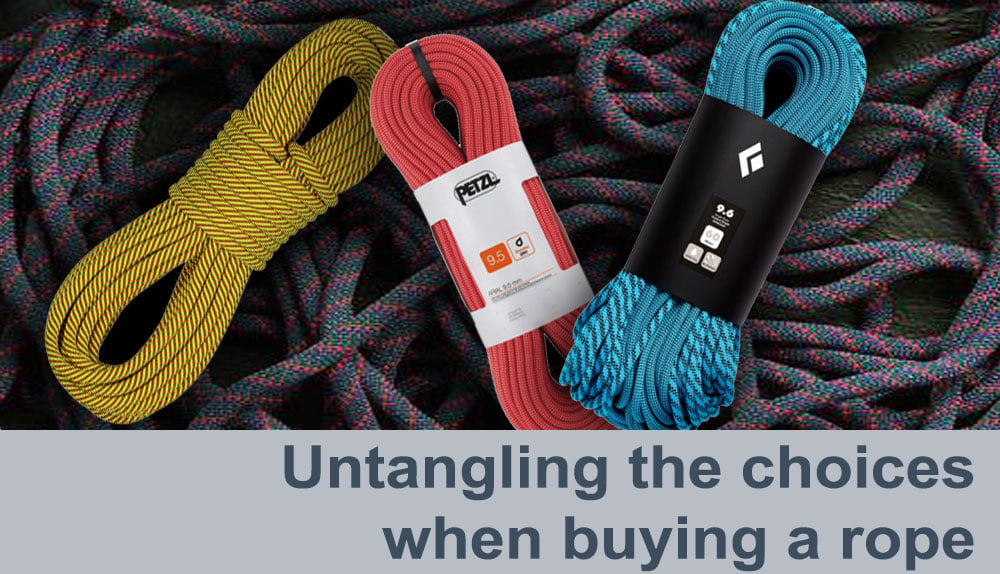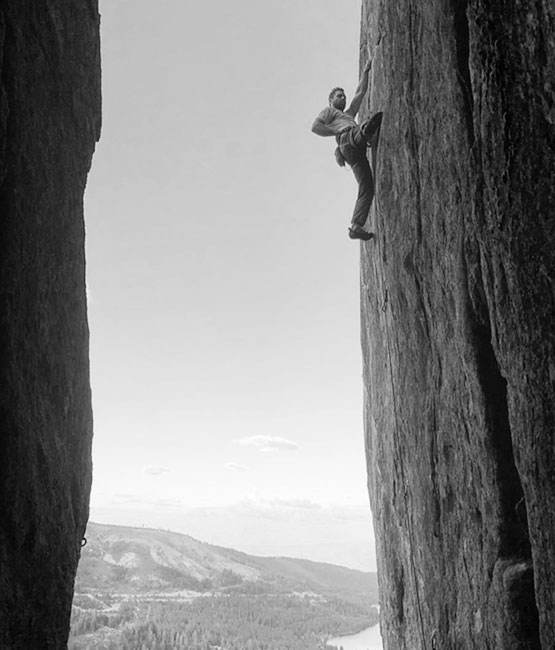How To Choose a Climbing Rope

by Jedidiah Kravitz
When looking to buy a new rope, sometimes all the different options can be a bit overwhelming. Every brand offers different lengths, diameters, and treatments. So how do you know which rope will be the best for you? First off, the most important thing to ask yourself is what is going to be the purpose of this rope? Are you planning to use it solely for top-ropes? Is it going to be your crag workhorse rope? Are you looking to get a rope for projecting your hardest sport climb? Do you want a light and solid alpine rope? Once you have identified this, then you will be able to narrow down your selection to find the perfect rope for you!
After you have figured out what you are mainly going to be using your rope for, then you can move on to diameter. These days, single ropes range in diameter from as skinny as 8.5mm up to 11mm and probably bigger than that, but I feel anything over 10.2 is a little much for free climbing. If you are just getting into climbing, then I would go for a fatter diameter rope, in the range of 9.8-10.2. The reason being that the fatter the rope is, the more durable and the longer it is going to last for you. For someone who is just getting into the sport, they will most likely be setting up a lot more top ropes which can create a lot of wear on your rope. This is why I recommend going for a wider diameter rope to take the abuse and have an overall longer life.
The next size down in diameter range let's say 9.4-9.8, I think is great for your cragging rope. The positives of a skinny rope are its weight. It is lighter when hauling it up a climb and the catch softer when you take a lead fall. On the negative side, the rope is rated for fewer falls so it will not last as long as a thicker rope. This is where you need to ask yourself again what exactly you want your rope for. I would say if you just plan to climb up on the summit all the time then I think that between a 9.6-9.8 is the sweet spot. 9.6 is kind of the ideal cragging rope for me as I feel it is light and provides a good catch but also not too skinny.
Finally comes the thinnest rope range, 8.5-9.4mm. Once you get into this range, you are getting into alpine ropes. The skinnier they are, the lighter they will be for those long approaches! Ropes in the 9.2-9.4 ranges I feel can also be a perfect rope for hard sport climbing projects as they are light and will provide a nice soft catch. Anything below a 9.2, I would save for alpine days as they will wear out quickly with everyday use.
Once you have chosen a diameter, then you can move onto the length of the rope. Rope lengths have gotten longer and longer over the years. Where a 50m may have been the old standard it has generally progressed. These days I feel the majority of people climb with 60-70m ropes. 80m have also become more popular and may even be necessary at some climbing areas that have long 40m pitches. If you are only getting a cragging rope and your local cliff only has routes that are a max 30m length, then I would recommend going with a 60m. Anything over that is just extra weight and overkill in my opinion. That being said, maybe you have a crag that has routes longer than 30m, in which case, you will need a longer rope. Long ropes can be great for alpine routes that have long pitches. They can also be helpful and safer when rappelling routes as they will allow you to rappel down farther without worrying about rapping off the end of your rope. The negative side to having a longer rope is that it is more weight that you will have to carry around with you to and from the rock climbs that you want to do.

Finally, you need to decide if you would like a rope that is dry treated or not. The benefit of going with a dry-treated rope is that it not only is better protected from the weather but also more abrasion resistant and will have a longer life. The negative is that due to these treatments, the rope will cost a little bit more. I feel like if you are in a position where you have the extra money, it's worth paying for a rope dry treatment rope. Another thing that may be worth paying a little extra for is a rope with a bi-pattern. The bi-pattern makes it easy to tell where the center of the rope is when rappelling as it changes patterns halfway through. These can make rappelling of routes much safer as sometimes the standard middle mark on ropes will begin to fade with time.
Hopefully, all this information will help you the next time you are looking to purchase a brand new rope. Overall, I think it is most important to figure out exactly what it is that you are planning to use the rope for. This will dictate all the other decisions you will have to make on length, size, and treatment.
Here are some great selections for ropes we offer at Granite Chief based on the type of climbing you are into:
Donner summit crag lead rope: Sterling 9.6 Quest 60m. The 60m will be plenty sufficient for almost all climbs on donner except if you are looking to rappel off Lizard Ledge on Black Wall. If so, I would go with the 70m length.
I hope I've cleared up some of the confusion and questions when shopping for a climbing rope. If you're new to the sport, the gear can be a bit overwhelming.
Granite Chief has a good selection of ropes as well as harnesses, climbing shoes, chalk, well pretty much everything you'll need for a good climb on Donner Summit.
NOTE: Donner Summit is the preeminent spot to climb in the Tahoe area, with trad, multi-pitch, sport, and bouldering on quality rock and beautiful views. You might want to add the guidebook, North Tahoe-A Rock Climber's Guide to your climbing kit. The book covers climbing on Donner Summit, Big Chief, Old County Road, and more. Many of the routes have been photographed with drones, it's an excellent book. I highly recommend you grab one.